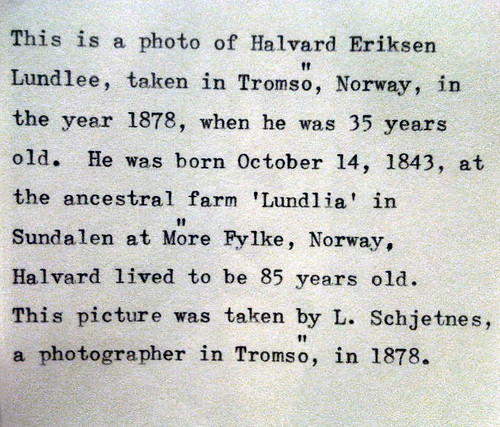typing "foreign" accents.

Russell McGorman
Posts: 275

This I found this note taped to the back of a picture from one of my family's photo albums.
My question: Were there typewriters that could type accents? It must have been very tedious to stop and reposition the platen very carefully for each accent. There are a lot of accented character is latin based scripts... Which would make for some pretty sophisticated machines or some very frustrated typists.
This note would have been typed in North America. Likely in Vancouver or Seattle. I'd hope a Norwegian in Norway would not have to go go to such pains to type an accented character. Halvard is here in case you are curious.
Tagged:
2
Comments
-
I tried googling some of this. Now I know that Lithuanian Typewriter has an unexpected meaning…1
-
Czech typewriters had "precomposed" common (l/c) characters, as well as single umlaut, caron, grave and acute keys. I do not remember whether you had to back-space to go under these or whether they were non-advancing.1
-
When I was a kid in Canada, we had a manual typewriter that I'd use for French homework. It had a circumflex and grave on the key to the right of the colon/semicolon. That key had no advance, so you'd type accent and the carriage would stay still . . . type the letter which would advance the carriage.
There was another key with a lowercase ç and é. I think if you wanted a capital Ç you'd have to backspace and comma or something. É is the only acute letter in French. There are few French words that start with É . . . not sure what the solution was for those situations.
1 -
Marvelous specimen.
"The exclamation mark did not have its own dedicated key on standard manual typewriters before the 1970s. Instead, one typed a period, backspaced, and typed an apostrophe [aka single quote]."
Wikipedia
I think they were used to hitting the backspace, and there was no careful positioning required for a double strike in mono spaced fonts then.2 -
Thanks.
The adjustment I was thinking of is vertical. The platen was rotated to raise the double quote above the letter, though come to think, since the note is double spaced I guess the mark is on he line in between.0 -
though come to think, since the note is double spaced I guess the mark is on he line in between
From my long-ago experience with typewriters, the vertical advance had "clicks," where two clicks equalled a line. I'd guess the quotation marks in the sample were added after the vowel one backspace back and one "click" (rather than two) up. Then click back down one and be on your merry way.1 -
Exactly. Pain in the butt.
 ) 0
) 0 -
@ James, Now I know that Lithuanian Typewriter has an unexpected meaning…
dare I ask?0 -
The European typewriters were distributed with different keyboard layouts in each country. Each keyboard was equipped with more or less practical set (or subset) of local characters. And in may countries the system is preserved in the computer keyboard layouts until today.
For instance the standard Czech keyboard layout is qwertz and the first raw of characters does not include numbers (from 1 to 0) but local characters +ěščřžýáíé. To type uppercase characters you have to type the accent first ˇ and then the base letter (there was a special key for acute and caron). The accents were nonspacing so it was quite efficient. Some accents were not available on the keyboard (ring) so typing Ů required typing U first followed by backspace, rolling the paper slightly down and typing o and the rolling the paper back to keep the baseline. Also Czech characters with comma-like accent (ď ť) were inappropriately composed from ˇand d/t.
And yes, we use the same system of typing Czech characters now on all platforms be it Windows, OS X, Linux, or Android. (The only exception is the iPhone, its keyboard engineers decided to ignore the rules established more than 110 years ago.)
There were many slightly different keyboard layouts on the market, some of the machines didn’t have the keys for 1 (one) and 0 (zero), thus the user had to type l (lowercase L) or O (capital O) respectively. Some layouts featured German umlaut ¨(many Czech surnames are of German origin), otherwise users had to type the letter using the quotes ". You can see one of the Czech typewriter keyboards here: http://upload.wikimedia.org/wikipedia/commons/b/b4/Consul_typewriter.jpg2
Categories
- All Categories
- 46 Introductions
- 3.9K Typeface Design
- 487 Type Design Critiques
- 564 Type Design Software
- 1.1K Type Design Technique & Theory
- 656 Type Business
- 861 Font Technology
- 29 Punchcutting
- 521 Typography
- 119 Type Education
- 325 Type History
- 77 Type Resources
- 112 Lettering and Calligraphy
- 33 Lettering Critiques
- 79 Lettering Technique & Theory
- 559 Announcements
- 94 Events
- 114 Job Postings
- 170 Type Releases
- 180 Miscellaneous News
- 276 About TypeDrawers
- 54 TypeDrawers Announcements
- 120 Suggestions and Bug Reports




